check engine GMC YUKON DENALI 2003 Owner's Guide
[x] Cancel search | Manufacturer: GMC, Model Year: 2003, Model line: YUKON DENALI, Model: GMC YUKON DENALI 2003Pages: 447, PDF Size: 21.97 MB
Page 308 of 447

I
1. To remove the engine air cleaner/filter, loosen the
screws on the cover.
2. Lift the cover upward and remove the engine air
cleaner/filter
out of the air cleaner housing. Care
should be taken to dislodge as little dirt as possible.
3. Clean the filter sealing surface and the housing.
4. Install the new engine air cleanedfilter. Refer
to the Maintenance Schedule to determine when
to replace the engine air cleanedfilter. See
Part 5:
Owner Checks and Services on page 6- 10.
Operating L.L engine _____. the air cleaner/filter
off can cause you or others to be burned. The
air cleaner not only cleans the air,
it stops
flame if the engine backfires.
If it isn’t there
and the engine backfires, you could be burned. Don’t drive with
it off, and be careful working
on the engine with the air cleanedfilter
off.
Notice: If the air cieaner/filter is off, a backfire can
cause a damaging engine fire. And, dirt can
easily get into your engine, which will damage
it.
Always have the air cleanedfilter in place when
you’re driving.
5. Install the cover and tighten the screws.
5-1 9
Page 309 of 447

Automatic Transmission Fluid
When to Check and Change
A good time to check your automatic transmission fluid
level is when the engine oil is changed.
Change both the fluid and filter every
50,000 miles
(83
000 km) if the vehicle’s GVWR is over 8,600 or if
the vehicle is mainly driven under one or more of these
conditions:
In heavy city traffic where the outside temperature
regularly reaches 90°F (32°C) or higher.
0 In hilly or mountainous terrain.
When doing frequent trailer towing.
Uses such as found in taxi, police or delivery
service.
If your vehicle’s GVWR is not over 8,600 and you do
not use your vehicle under any of these conditions,
change the fluid and filter every
100,000 miles
(1 66 000 km).
How to Check
Because this operation can be a little difficult, you may
choose to have this done at the dealership service
department.
If you do it yourself, be sure to follow all the instructions
here, or you could get a false reading on the dipstick.
Notice: Too much or too little fluid can damage
your transmission. Too much can mean that some of the fluid could come out and fall
on hot engine
part or exhaust system parts, starting a fire.
Too little fluid could cause the transmission to
overheat. Be sure to get an accurate reading if you
check your transmission fluid.
Wait at least 30 minutes before checking the
transmission fluid level
if you have been driving:
When outside temperatures are above 90°F (32°C).
At high speed for quite a while.
In heavy traffic - especially in hot weather.
While pulling a trailer.
See
Part A: Scheduled Maintenance Services on
page 6-4.
5-20
Page 310 of 447

To get the right reading, the fluid should be at normal
operating temperature, which is 180°F
to 200°F
(82°C
to 93°C).
Get the vehicle warmed up by driving about 15 miles
(24 km) when outside temperatures are above 50°F
(10°C). If it's colder than 50°F
(IO'C), drive the vehicle
in THIRD
(3) until the engine temperature gage
moves and then remains steady for
10 minutes.
A cold fluid check can be made after the vehicle has
been sitting for eight hours or more with the engine
off,
but this is used only as a reference. Let the engine
run at idle for five minutes
if outside temperatures are
50°F (10°C) or more.
If it's colder than 50°F (IO'C), you
may have to idle the engine longer. Should the fluid
level be low during this cold check,
you must check the
fluid hot before adding fluid. Checking the fluid hot
will give you a more accurate reading of the fluid level.
Checking the Fluid Level
Prepare your vehicle as follows:
@ Park your vehicle on a level place. Keep the engine
running.
With the parking brake applied, place the shift lever
in PARK (P).
With your foot on the brake pedal, move the shift
lever through each gear range, pausing for about
three seconds in each range. Then, position the shift
lever in
PARK (P).
@ Let the engine run at idle for three minutes or more.
Then, without shutting
off the engine, follow
these steps:
1- The transmission dipstick handle with the graphic is
located at the rear of
the engine compartment,
on the passenger's side.
5-21
Page 311 of 447
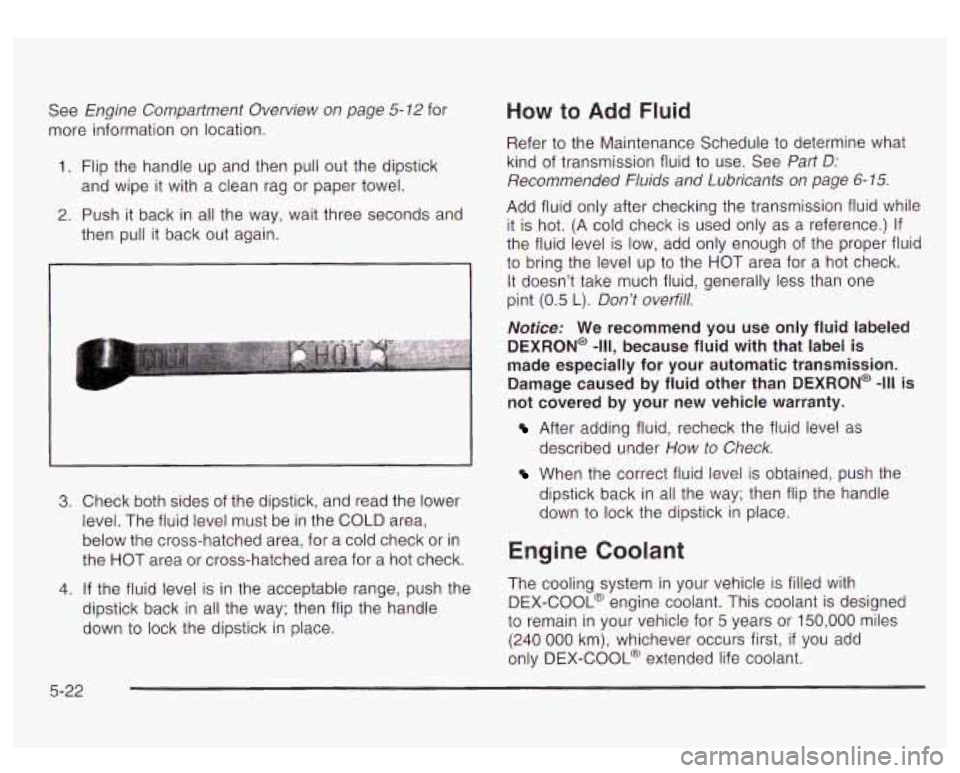
See Engine Compartment Overview on page 5-12 for
more information on location.
1. Flip the handle up and then pull out the dipstick
and wipe it with a clean rag or paper towel.
2. Push it back in all the way, wait three seconds and
then pull it back out again.
3. Check both sides of the dipstick, and read the lower
level. The fluid level must be in the COLD area,
below the cross-hatched area, for a cold check or in
the HOT area or cross-hatched area for a
hot check.
4. If the fluid level is in the acceptable range, push the
dipstick back in all the way; then flip the handle
down
to lock the dipstick in place.
How to Add Fluid
Refer to the Maintenance Schedule to determine what
kind of transmission fluid
to use. See Part D:
Recommended Fluids and Lubricants on page 6-15.
Add fluid only after checking the transmission fluid while
it is hot. (A cold check is used only as
a reference.) If
the fluid level is low, add only enough of the proper fluid
to bring the level up to the HOT area for a hot check.
It doesn't take much fluid, generally less than one
pint (0.5 L). Don't overfill.
Notice: We recommend you use only fluid labeled
DEXRON@
-111, because fluid with that label is
made especially for your automatic transmission.
Damage caused by fluid other than DEXRON@
-111 is
not covered by your new vehicle warranty.
After adding fluid, recheck the fluid level as
described under How to Check.
When the correct fluid level is obtained, push the
dipstick back in all the way; then flip the handle
down
to lock the dipstick in place.
Engine Coolant
The cooling system in your vehicle is filled with
DEX-COOL@ engine coolant. This coolant is designed
to remain in your vehicle for 5 years or 150,000 miles
(240 000 km), whichever occurs first, if you add
only DEX-COOL@ extended life coolant.
5-22
Page 313 of 447

If you have to add coolant more than four times a year,
have your dealer check your cooling system.
Notice: If you use the proper coolant, you don’t
have to add extra inhibitors or additives which claim
to improve the system. These can be harmful.
Checking Coolant
The coolant surge tank is
located in the engine
compartment on the
passenger’s side of the
vehicle.
.
1 ~ ---lg the surge tanl- ,xessure cap when the
engine and radiator are hot can allow steam
and scalding liquids to blow out and burn you badly. Never turn the surge tank pressure
cap
- even a little - when the engine and
radiator are hot.
The vehicle must be on a level surface. When your
engine is cold, the coolant level should be at the FULL
COLD mark.
If the LOW COOLANT
LEVEL message comes on and
stays on, it means you’re low on engine coolant.
See “Low Coolant Level” under
DIC Warnings and
Messages on page
3-52.
See Engine Compartment Overview on page 5-12 for
more information on location.
5-24
Page 318 of 447
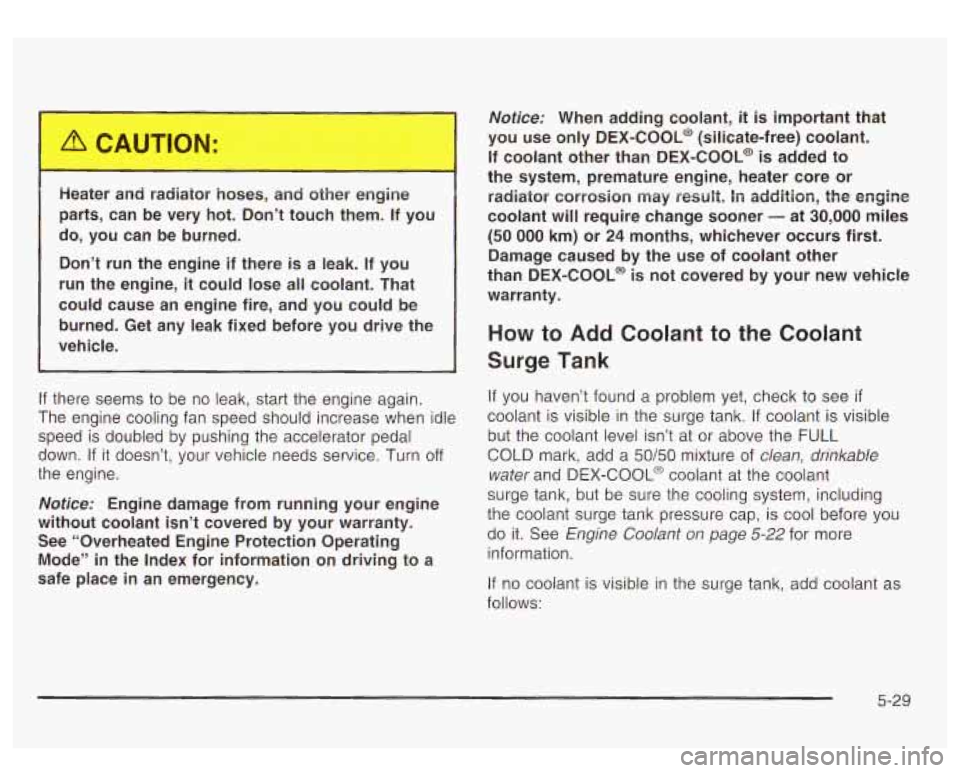
Heater and rac.-:or hoses, and other engine
parts, can be very hot. Don’t touch them. If you
do, you can be burned.
Don’t run the engine
if there is a leak. If you
run
the engine, it could lose all coolant. That
could cause an engine fire, and you could be
burned. Get any leak fixed before you drive the
vehicle.
If there seems to be no leak, start the engine again.
The engine cooling fan speed should increase when idle
speed is doubled by pushing the accelerator pedal
down. If it doesn’t, your vehicle needs service. Turn
off
the engine.
Notice: Engine damage from running your engine
without coolant isn’t covered by your warranty.
See “Overheated Engine Protection Operating
Mode”
in the Index for information on driving to a
safe place
in an emergency.
Notice: When adding coolant, it is important that
you use only
DEX-COOL@ (silicate-free) coolant.
If coolant other than DEX-COOL@ is added to
the system, premature engine, heater core or radiator corrosion
may result. In addition, the engine
coolant will require change sooner
- at 30,000 miles
(50 000 km) or 24 months, whichever occurs first.
Damage caused by
the use of coolant other
than DEX-COOL@ is not covered by your new vehicle
warranty.
How to Add Coolant to the Coolant
Surge Tank
If you haven’t found a problem yet, check to see if
coolant is visible in the surge tank. If coolant is visible
but the coolant level isn’t at or above the
FULL
COLD mark, add a 50/50 mixture of clean, drinkable
water and
DEX-COOL@ coolant at the coolant
surge tank, but be sure the cooling system, including
the coolant surge tank pressure cap, is cool before you
do it. See Engine Coolant on
page 5-22 for more
information.
If no coolant is visible in the surge tank, add coolant as
follows:
5-29
Page 323 of 447
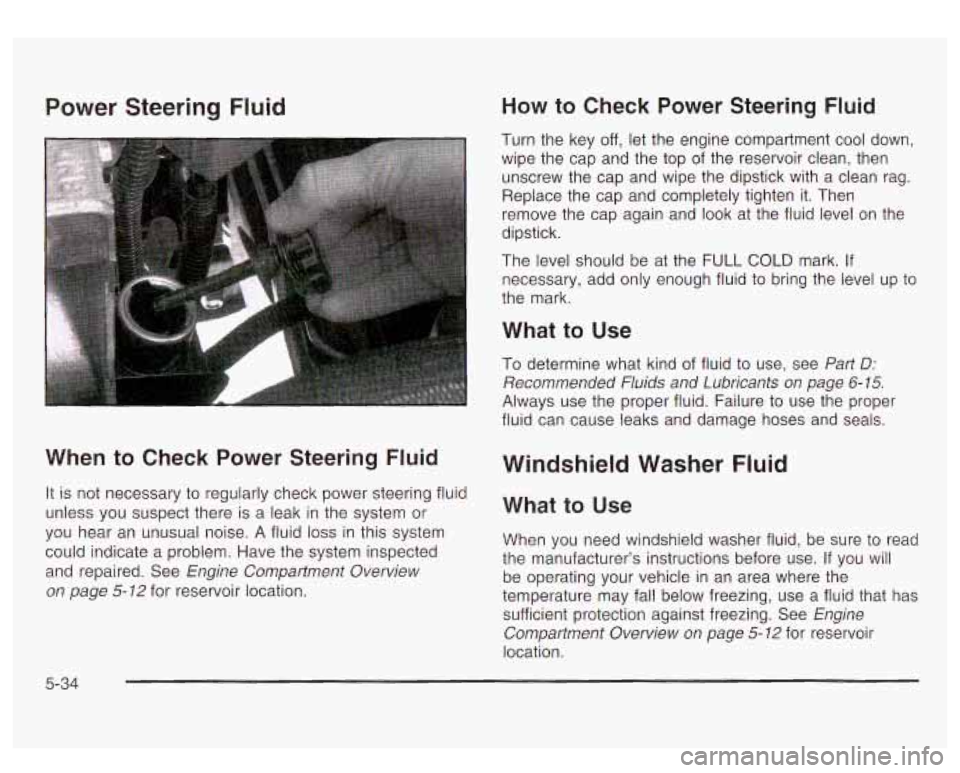
Power Steering Fluid
-
When to Check Power Steering Fluid
It is not necessary to regularly check power steering fluid
unless you suspect there is a leak in the system or
you hear an unusual noise. A fluid
loss in this system
could indicate a problem. Have the system inspected
and repaired. See Engine Compartment Overview
on page
5-72 for reservoir location.
How to Check Power Steering Fluid
Turn the key off, let the engine compartment cool down.
wipe the cap and the top of the reservoir clean, then
unscrew the cap and wipe the dipstick with a clean rag.
Replace the cap and completely tighten it. Then
remove the cap again and look at the fluid level on the
dipstick.
The level should be at the
FULL COLD mark. If
necessary, add only enough fluid to bring the level up to
the mark.
What to Use
To determine what kind of fluid to use, see Part D:
Recommended Fluids and Lubricants on page 6-15.
Always use the proper fluid. Failure to use the proper
fluid can cause leaks and damage hoses and seals.
Windshield Washer Fluid
What to Use
When you need windshield washer fluid, be sure to read
the manufacturer's instructions before use. If you will
be operating your vehicle in an area where the
temperature may fall below freezing, use a fluid that has
sufficient protection against freezing. See Engine
Compartment Overview on page
5-72 for reservoir
location.
5-34
Page 325 of 447
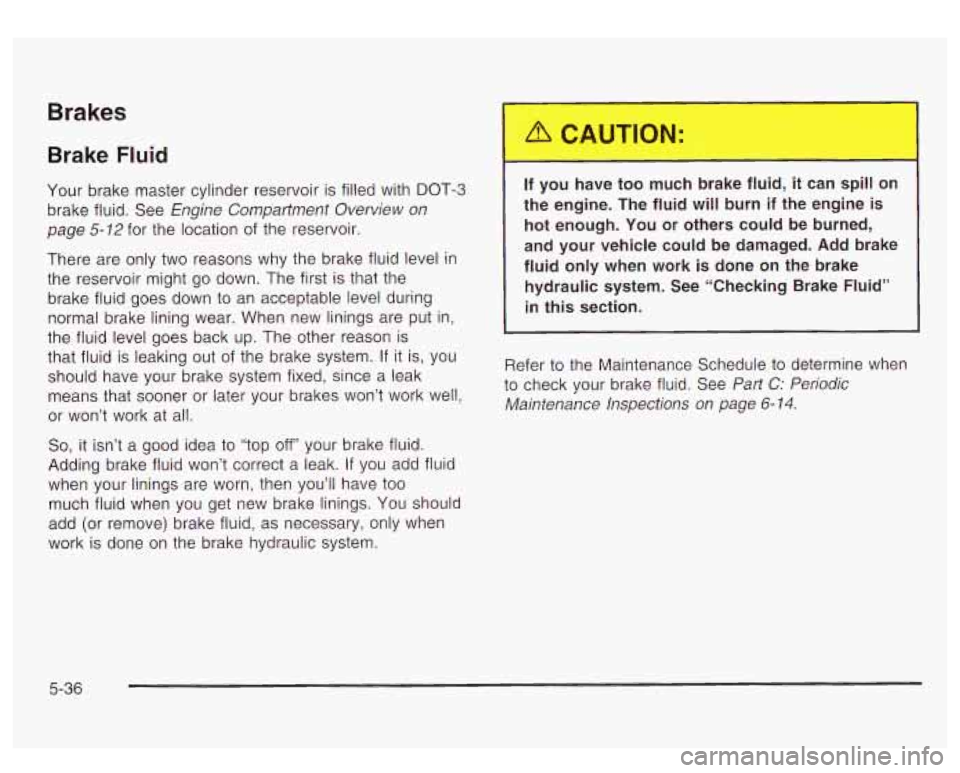
Brakes
Brake Fluid
Your brake master cylinder reservoir is filled with DOT-3
brake fluid. See Engine Compartment Overview on
page
5-12 for the location of the reservoir.
There are only two reasons why the brake fluid level in
the reservoir might go down. The first is that the
brake fluid goes down to an acceptable level during
normal brake lining wear. When new linings are put in,
the fluid level goes back up. The other reason is
that fluid is leaking out of the brake system. If it is, you
should have your brake system fixed, since a leak
means that sooner or later your brakes won’t work well,
or won’t work at all.
So, it isn’t a good idea to “top off’ your brake fluid.
Adding brake fluid won’t correct a leak. If you add fluid
when your linings are worn, then you’ll have
too
much fluid when you get new brake linings. You should
add (or remove) brake fluid, as necessary, only when
work is done on the brake hydraulic system.
If you have too n._.:h brake ------) it can s,
the engine. The fluid will burn if the enginc
... I on
e is
hot enough. You or others could be burned,
and your vehicle could be damaged. Add brake
fluid only when work is done
on the brake
hydraulic system. See “Checking Brake Fluid”
in this section.
Refer to the Maintenance Schedule to determine when
to check your brake fluid. See Part C: Periodic
Maintenance Inspections on page
6- 14.
5-36
Page 332 of 447

5. Check that the jumper cables don’t have loose or
missing insulation. If they do, you could get a
shock. The vehicles could be damaged too.
Before you connect the cables, here are some
basic things you should know. Positive
(+) will go to
positive (+) or to a remote positive terminal (+) if
the vehicle has one. Negative (-) will go to a heavy,
unpainted metal engine part or
to a remote
negative
(-) terminal, if the vehicle has one.
Don’t connect positive
(+) to negative (-) or you’ll
get a short that would damage the battery and
maybe other parts
too.
Fans or other moving engine parts can injure
you badly. Keep your hands away from moving
parts once the engine is running.
6. Connect the red
positive
(+) cable to the
positive
(+) terminal of the
dead battery. Use a
remote positive
(+)
terminal if the vehicle
has one.
7. Don’t let the other end
touch metal. Connect it
to the positive
(+)
terminal of the good
battery. Use a remote positive
(+) terminal
if the vehicle has one
5-43
Page 385 of 447
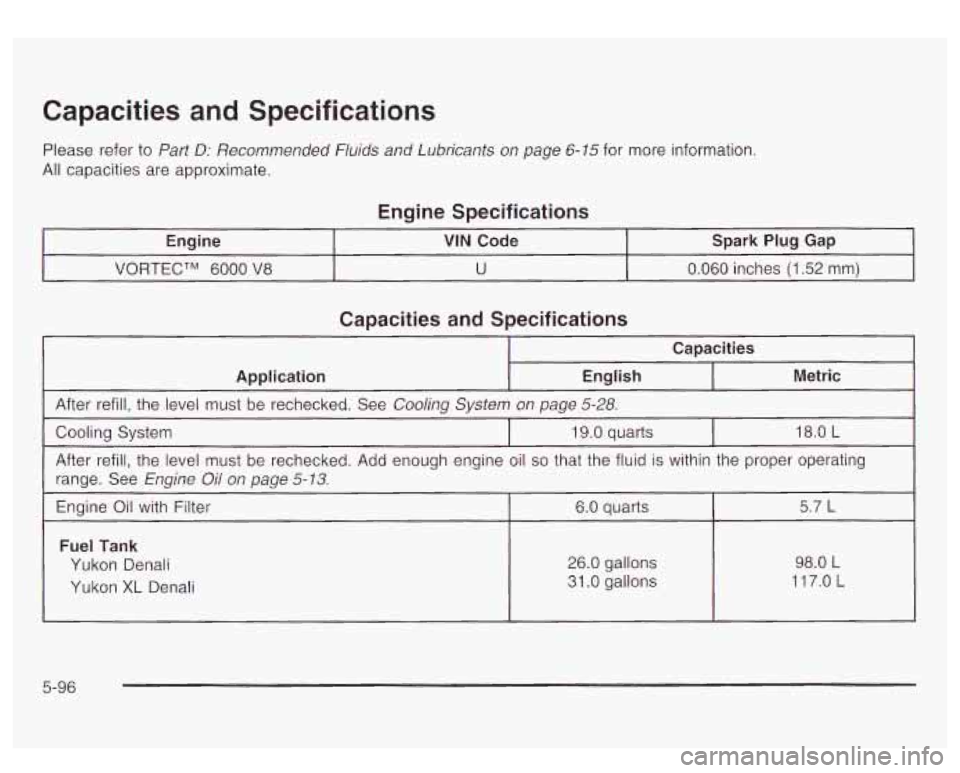
Capacities and Specifications
Please refer to Part D: Recommended Fluids and Lubricants on page 6-15 for more information.
All capacities are approximate.
Engine Specifications
Engine VIN Code 1 Spark Pluq GaD - I t -
VORTECTM 6000 V8 U I 0.060 inches (1.52 mm)
Capacities and Specifications
Capacities
Application Metric
English
After refill, the level must be rechecked. See Cooling System on page 5-28.
Cooling System 19.0 quarts 18.0 L
After refill, the level must be rechecked. Add enough engine oil so that the fluid is within the proper operating
range. See Engine Oil on page
5-13.
Engine Oil with Filter
Fuel Tank
5.7 L 6.0 quarts
Yukon Denali
Yukon
XL Denali
26.0 gallons
31 .O gallons
98.0 L
117.0 L
5-96